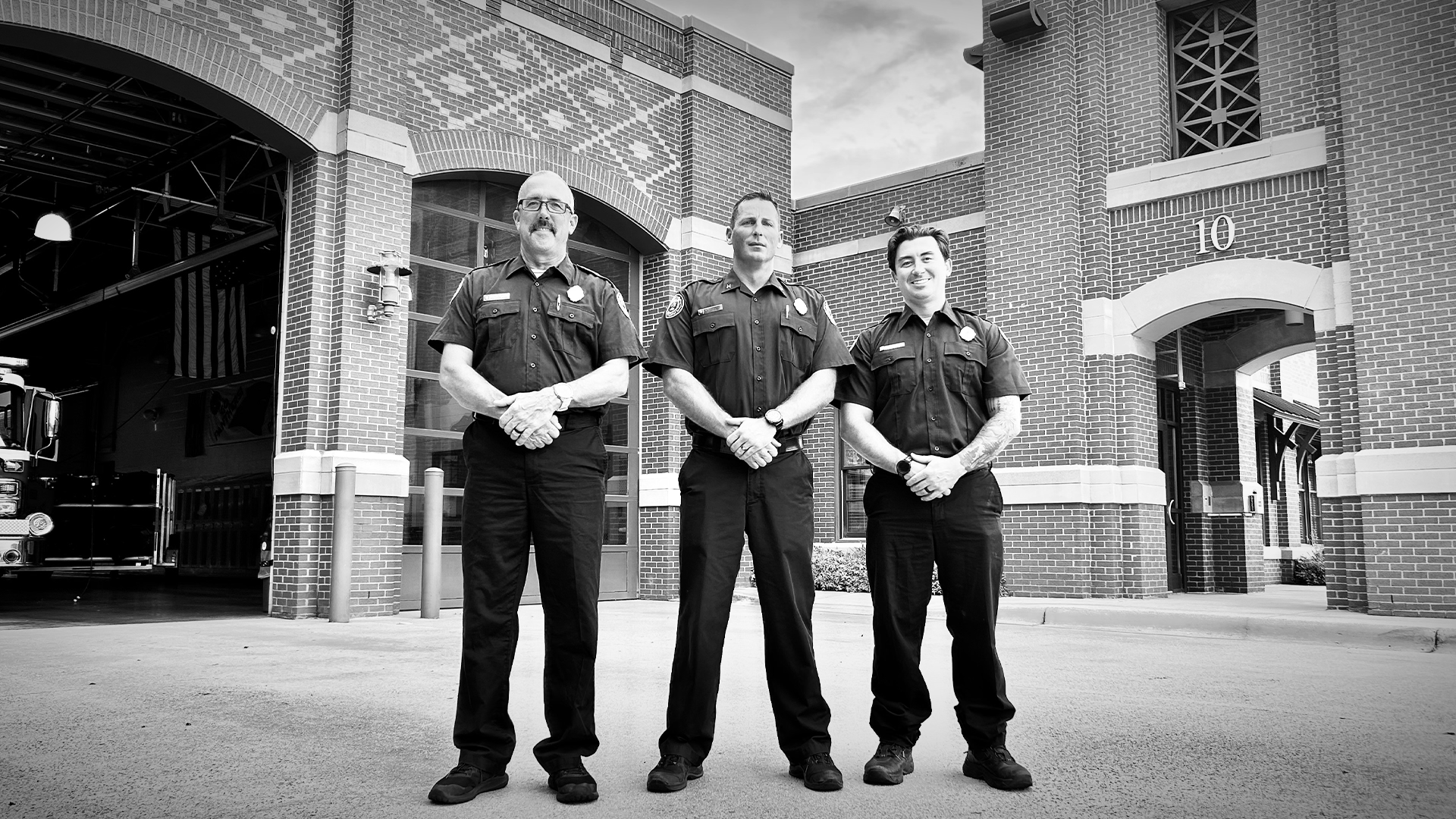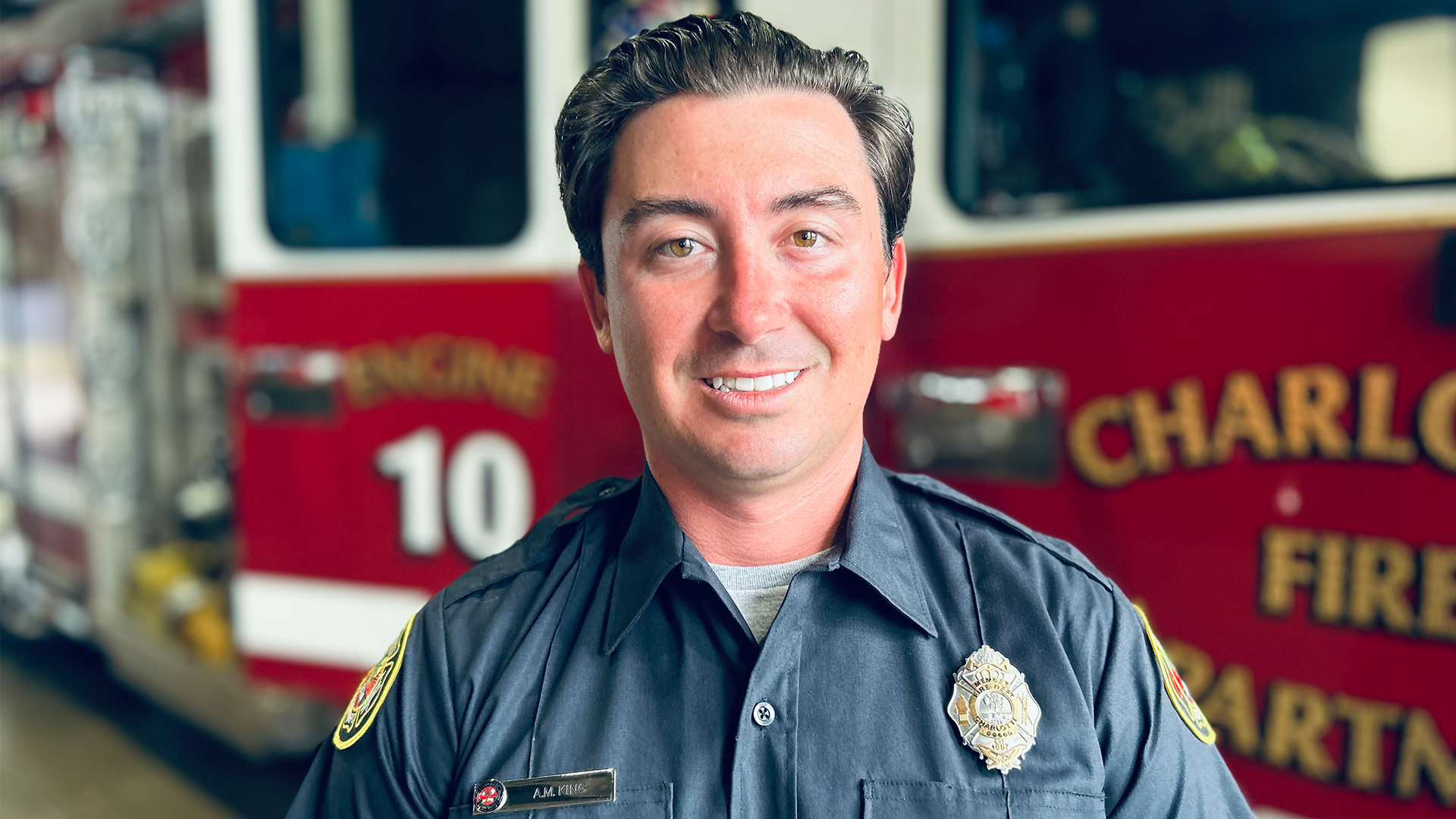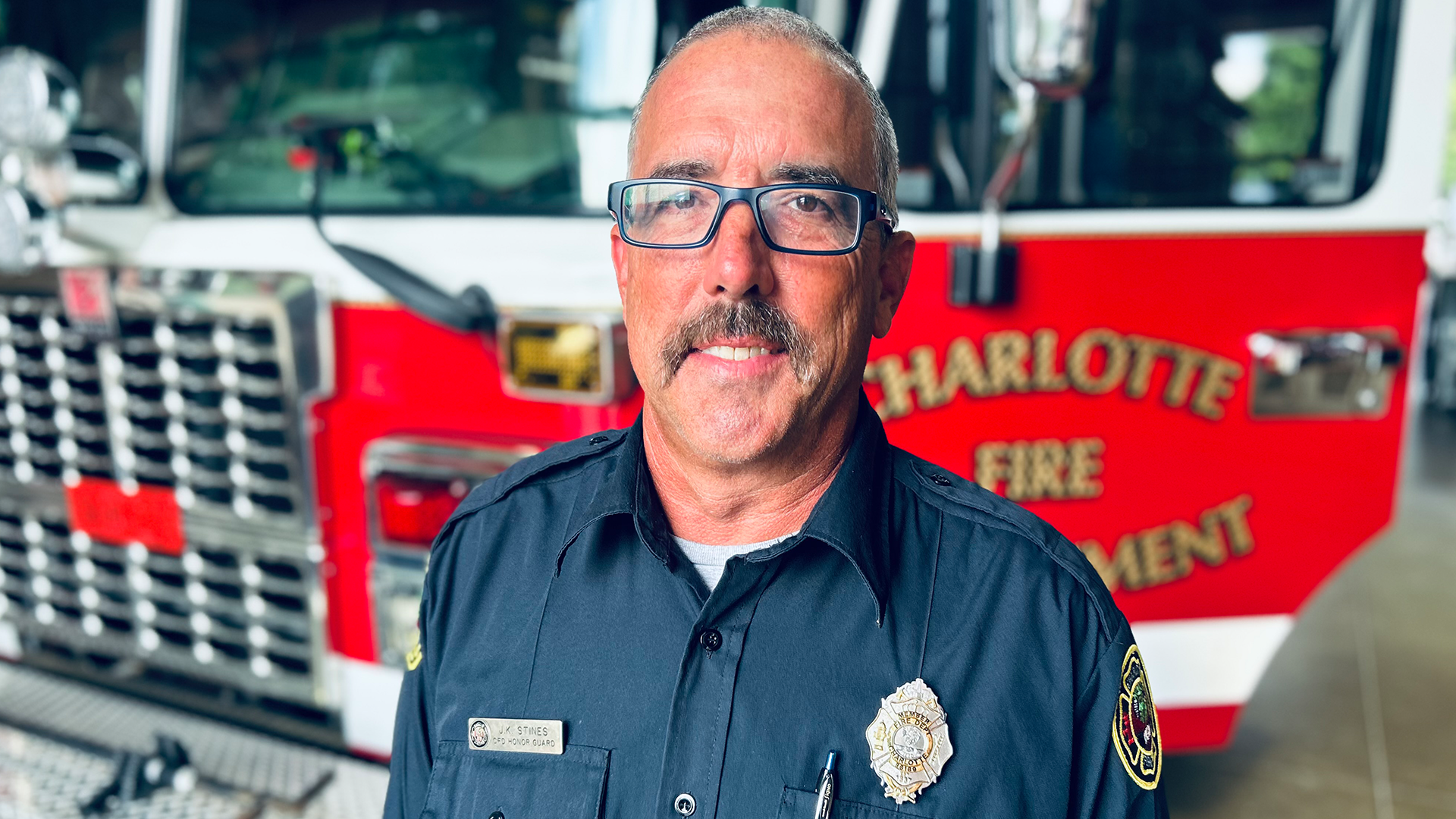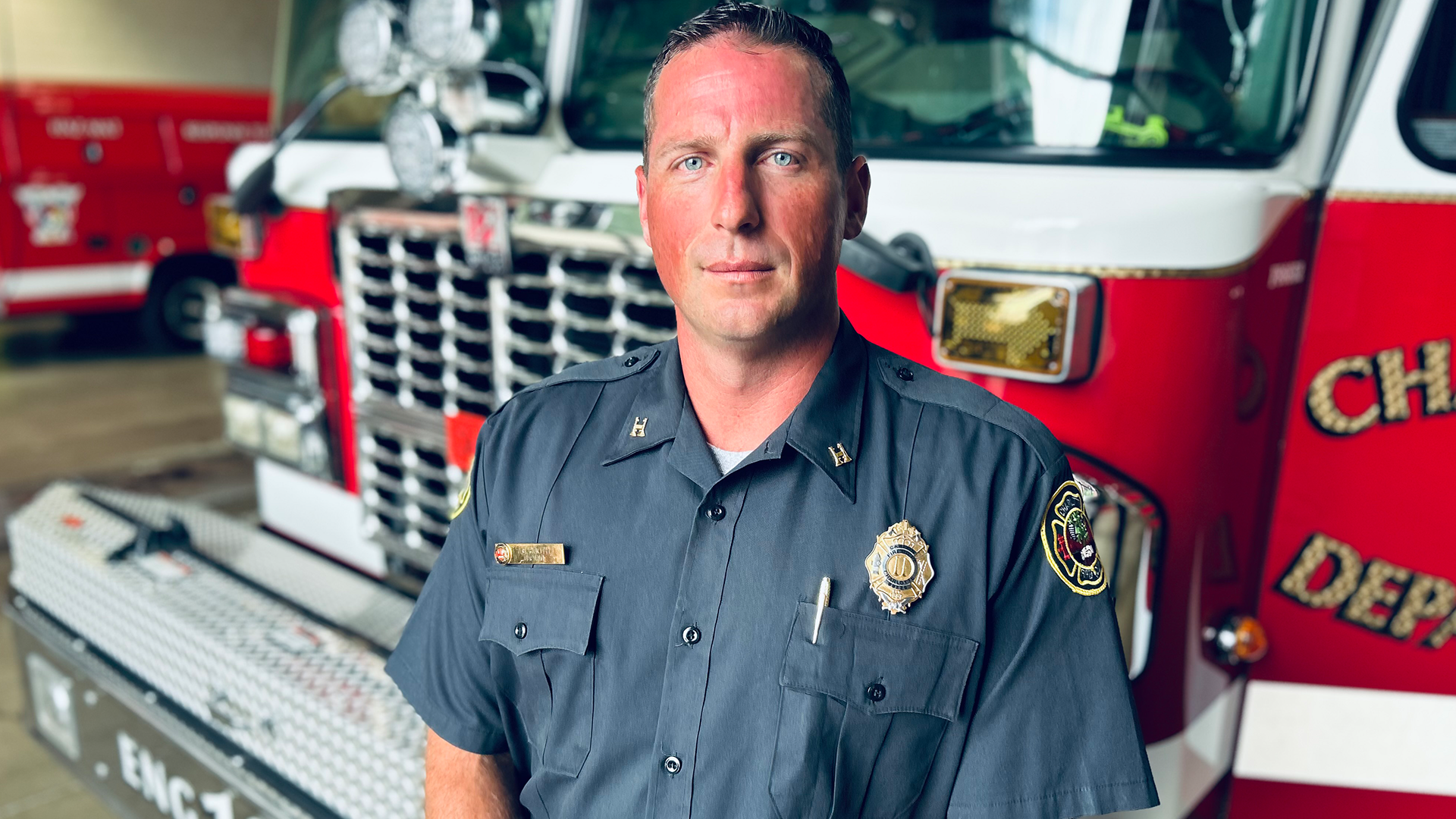New Mom Says Charlotte Firefighters of Engine 10 Saved Her Life
Published on July 30, 2025

Julie Brauer and Nick Webster reunite with Charlotte Fire’s Engine 10 crew, whose quick actions saved Julie’s life after a medical emergency.
By Kevin Campbell, Charlotte Fire
On July 5, 2025, what began as a seemingly routine medical call for the crew of Charlotte Fire Engine 10 quickly became a life-or-death emergency. Captain John Booth, Engineer Kevin Stines, Firefighter II and Lead EMT Austen King, and Firefighter I Mauro Samayoa-LaForgia were dispatched at 6:06 p.m. The notes in the call log gave no indication of the intense and emotional scene they were about to encounter.
“I remember the call came out as a routine hemorrhage,” said Captain Booth. “Nothing in the notes really led us to believe it would be anything out of the ordinary. But no call is truly routine, because you never know what you’re going to encounter when you get there.”
The firefighters arrived on scene at 6:09 p.m., just three minutes after leaving Firehouse 10. As they climbed the steps to the family’s home, it became clear this was no routine call.

Captain John Booth, Engineer Kevin Stines, and Firefighter II Austen King stand outside Firehouse 10, where their teamwork is at the heart of their mission.
“When I got to the top of the steps, I noticed a lot of blood on the floor leading to the bathroom,” Booth recalled. “At that point, it was pretty evident that this was life-threatening. The crew immediately went in and started providing emergency care.”
Inside the bathroom, Julie Brauer was sitting on the toilet, pale and fading in and out of consciousness. She had given birth to her first child, Jack, just two weeks earlier.
“She was almost ashen white, like a wax figure,” Booth said. “Austen started applying direct pressure to try and control or stop the bleeding. We needed to move quickly.”
Julie’s husband, Nick Webster, was already in a panic when the firefighters arrived.
“I was holding our newborn son, trying to figure out what to do,” Nick said. “She was bleeding so much, and I didn’t know how to help. When Engine 10 arrived, it felt like everything went from chaos to controlled urgency in seconds.”

Julie Brauer and Nick Webster reflect on the life-saving care Julie received from Charlotte Fire’s Engine 10 crew.
Firefighter II Austen King remembers that moment vividly.
“As soon as we got to the second floor, we saw the amount of blood and realized this was life-threatening,” King said. “She passed out within 15 or 20 seconds of us being there. We knew time wasn’t on our side.”
King quickly began applying direct pressure while calmly speaking to Julie. “Any person in that situation doesn’t want to see someone panicking while giving them care,” King said. “I tried to stay calm and keep her calm. I treated her like I would treat a family member. I told her we were going to do everything we could to get her to the hospital quickly.”
Julie, who works in healthcare, said King’s calm presence made a life-changing difference.

Firefighter II and Lead EMT Austen King, whose calm focus made a lasting impact on Julie during the emergency call.
“Having a responder kneel down, look you in the eye, and talk to you like a person—it meant everything,” Julie said. “I was thinking, ‘Someone tell me I’m going to be okay.’ And Austen did that. He made me feel like I was safe, even when I thought I might not survive.”
As King applied pressure, Booth coordinated with Medic to expedite Julie’s transport. They decided to use a “mega mover,” a black tarp with handles that allows rescuers to quickly carry patients from tight spaces.
“It’s one of the fastest ways to move someone from a second story to a stretcher,” Booth explained. “We knew every second mattered.”
Engineer Kevin Stines helped prepare the mega mover while Firefighter I Mauro Samayoa-LaForgia supported King in stabilizing Julie for the move. “From the moment we saw her, we knew this was a ‘load and go’ situation,” Stines said. “She was pale—just ghost white. We laid the tarp down, got her onto it, and carried her downstairs as fast as we could.”
Nick watched in awe as the firefighters worked seamlessly with Medic. “They were so fast and so professional,” Nick said. “It felt like one second she was in the bathroom, and the next, they had her out the door and in the ambulance.”
Julie’s medical history made the situation even more critical. “I delivered Jack on June 22,” Julie said. “I had a C-section and hemorrhaged right after delivery. I lost about three liters of blood. Two weeks later, I was starting to feel like myself again. Then all of this happened, and I knew something was terribly wrong.”

Baby Jack, just two weeks old at the time of the emergency, now thriving thanks to the life-saving response from Charlotte Fire.
She vividly remembers the fear of waiting for help to arrive. “I called 911 and said, ‘I just delivered two weeks ago, I hemorrhaged, and I’m bleeding out right now.’ I thought I might bleed out and die at home. Then Austen walked in, and I just remember this overwhelming sense that someone was there to take care of me. I passed out, and when I came to, he told me I’d passed out but that I was going to be okay.”
For the firefighters, calls like this don’t fade quickly. “We run a lot of calls, and we rarely see the outcome,” Booth said. “To know we made a difference, that she’s alive and home with her baby—it’s incredibly rewarding.”
King was humble about his role. “I just did what anyone in Charlotte Fire would have done,” he said. “But I’ll never forget the look in her eyes when she came to. You realize in moments like that just how much this job matters.”
Stines agreed. “When you get a ‘thank you’ from a family like Julie’s, it’s refreshing. We’re there on people’s worst days, and to see them later, healthy and smiling, is the best reward.”

Engineer Kevin Stines of Engine 10, part of the crew that worked with precision to save Julie’s life.
Julie and Nick returned to Firehouse 10 later to thank the crew in person. “I kept thinking about how close I came to not being here,” Julie said. “The overwhelming feeling was gratitude. Who in the world is trying to keep me here? These guys. Because of them, I get to hold my baby boy every day.”
Nick added, “They were the calm in the storm. I’ll never forget how they treated Julie, how they treated all of us. They gave us more than medical care—they gave us hope.”
Charlotte Fire Chief Reginald Johnson praised the crew of Engine 10 for their actions that day. “This is what Charlotte Fire is all about, being there when seconds matter and making a difference in people’s lives,” Chief Johnson said. “Captain Booth, Engineer Stines, Firefighter II King, and Firefighter I Samayoa-LaForgia exemplified professionalism, skill, and compassion. Their actions saved a mother’s life and kept a family whole.”
Julie’s voice softens when she recalls being carried out of her home. “I was vulnerable, barely conscious, and these strangers treated me like family. I never felt panic from them—only care. That kind of humanity stays with you.”

Captain John Booth of Engine 10, who led the team during the life-saving July 5 call.
For the crew of Engine 10, the call is a reminder of why they chose this line of work. “It’s not about recognition,” Booth said. “It’s about knowing we were there when someone needed us most.”
King added, “Every call is different, but when you know you’ve saved a life, it’s something you carry with you forever.”